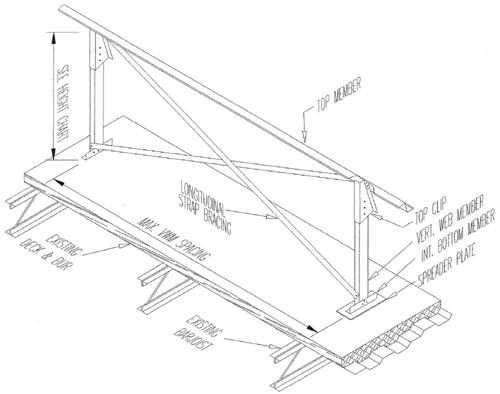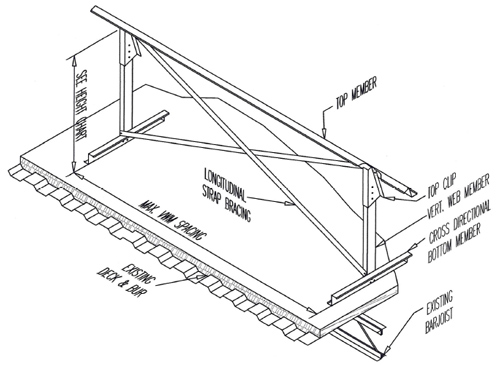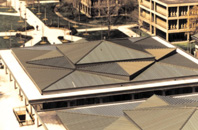CURA Adjust-A-Web
Bottom Members (BM)

The Intermittent Bottom Member (BM) is typically a relatively short angle (less than 18" long). It is used directly over existing structural elements, when the existing built up roof has enough compressive strength to withstand the loads transmitted by the Intermittent Bottom Member or when the existing built up roof is removed down to solid deck (metal deck or concrete). The Intermittent Bottom Member will rest on the built up roof or solid deck and in either case will be attached directly into the underlying structural member (beams, bar joist or structural concrete). This member is generally pre punched for the fasteners that attach the member to the existing structure.
Spreader Plates (SP) can be used to reduce the compressive load ifthe existing built up roof does not have adequate compressive strength. Spreader Plates are also generally pre punched.
The Intermittent Bottom Member is attached directly to the Vertical Web Member (VWM). The VWM is attached to the Top Member (TM) with an adjustable Top Clip (TC). (See other details for attachment and adjustable features.) These "post" assemblies are placed in a staggered pattern over the existing roof to spread the loads from the new system into the existing roof structure with minimum change to the existing structural loading.
Longitudinal Strap Bracing (S2) is installed at one location in each structurally continuous length of top member for longitudinal bracing of the system.

The Continuous Bottom Member (CBM) is installed parallel to the new roofTop Member and is typically a roll-formed ZEE shape made from 55 KSI steel. It is used when the existing structure is not compatible with the use of the Intermittent Bottom Member and the roof loads must be spread over several existing roof structural members (i.e.: small bar joist with less than 4' -0" spacing. wood joists, lightweight concrete with bulb tees, etc.). The Continuous Bottom Member is also often used when the existing structural members are spaced over 6' -0" apart. The Continuous Bottom Member rests on the built up roof, solid deck or existing structural members and is attached directly into the underlying structural member, while the vertical web member assembly is generally attached to the CBM's in a staggered pattern which mayor may not be directly related to the spacing of the underlying structure. These members are designed and sized to distribute the loads from the new roof system to the underlying structural members without consideration of any contribution from the existing roof deck.

The Cross Directional Bottom Member (CD) is laid perpendicular to the new roof Top Member and is typically a roll-formed ZEE shape made from 55 KSI steel. It is used when the existing structural members are parallel to the new Top Members.
The Cross Directional Bottom Member rests on the built up roof, solid deck or existing structural members and spans across and attaches into the existing structural members. Each CD must extend at least 6" beyond the existing structural member that is past the last vertical web member assembly. The vertical web member assembly is attached to the CD's in an inline pattern spaced to match the required top member spacing. This spacing is generally unrelated to the spacing of the underlying structure. These members are designed and sized to distribute the loads from the new roof system to the underlying structural members without consideration of any contribution from the existing roof deck.
Short Bottom Members (SBM)
Short Bottom Members are a variation of either a continuous or a Cross Directional Bottom Member. They are used when a bottom member is required in a number of places that only needs to span between (2) existing structural members. The length is therefore predictable and repetitive which allows the member to be factory cut to length thereby reducing field labor.






